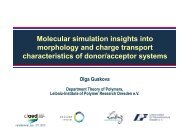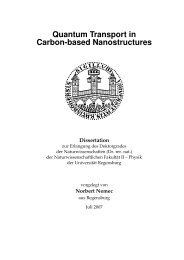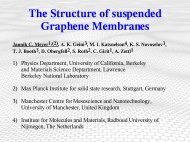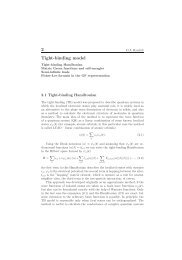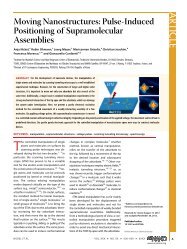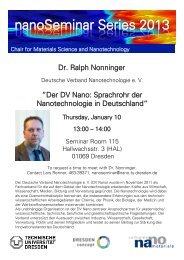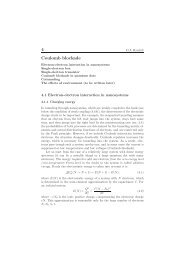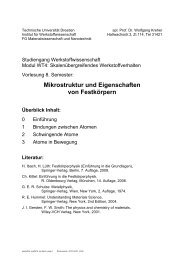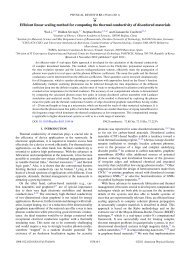slides (pdf)
slides (pdf)
slides (pdf)
You also want an ePaper? Increase the reach of your titles
YUMPU automatically turns print PDFs into web optimized ePapers that Google loves.
Ab-initio Assisted Process and Device<br />
Simulation for Nanoelectronic Devices<br />
As impl.<br />
SIMS<br />
Model<br />
800 o C<br />
20 min<br />
Wolfgang Windl<br />
MSE, The Ohio State University, Columbus, OH, USA<br />
Computational Materials Science and Engineering<br />
I<br />
V
Insulator<br />
(SiO 2 )<br />
+<br />
+<br />
Source<br />
+<br />
-<br />
P +<br />
N: e - , e.g. As<br />
(Donor)<br />
-<br />
Semiconductor Devices – MOSFET<br />
Metal Oxide Semiconductor Field Effect Transistor<br />
+<br />
+<br />
+<br />
-<br />
-<br />
-<br />
0V G<br />
Gate<br />
(Me)<br />
Channel<br />
-<br />
N<br />
Doping:<br />
-<br />
-<br />
-<br />
+<br />
+<br />
+<br />
+<br />
+<br />
Si<br />
Spacer<br />
P: holes, e.g. B<br />
(Acceptor)<br />
-<br />
+<br />
Drain<br />
+ +<br />
+ P +<br />
+<br />
-<br />
– V D<br />
Source<br />
+ P +<br />
Computational Materials Science and Engineering<br />
+<br />
+<br />
+<br />
+ +<br />
-<br />
Gate<br />
N<br />
+<br />
Drain<br />
+ +<br />
+ P<br />
+<br />
+ + +<br />
+<br />
+<br />
+<br />
+<br />
+<br />
+<br />
-<br />
- -<br />
+<br />
+<br />
+ +<br />
+<br />
+<br />
+ +<br />
-<br />
-<br />
- -<br />
-<br />
-<br />
– V G<br />
I D<br />
-<br />
Si<br />
– V D<br />
• Analog: Amplification<br />
• Digital: Logic gates<br />
-
1. Semiconductor Technology Scaling<br />
– Improving Traditional TCAD<br />
• Feature size shrinks on average by 12% p.a.; speed ∝ size<br />
• Chip size increases on average by 2.3% p.a.<br />
Overall performance: ↑ by ~55% p.a. or<br />
~ doubling every 18 months (“Moore’s Law”)<br />
Computational Materials Science and Engineering
Semiconductor Technology Scaling<br />
– Gate Oxide<br />
Gate oxide<br />
(SiO 2 )<br />
+<br />
+<br />
Source<br />
+<br />
-<br />
P +<br />
-<br />
+<br />
+<br />
Gate<br />
(Me)<br />
Channel<br />
+<br />
Drain<br />
+ +<br />
+ P +<br />
Computational Materials Science and Engineering<br />
+<br />
-<br />
-<br />
-<br />
0V G<br />
-<br />
-<br />
N<br />
-<br />
-<br />
+<br />
+<br />
+<br />
+<br />
+<br />
Si<br />
-<br />
+<br />
-<br />
– V D<br />
C = ε A/d<br />
+<br />
+<br />
+<br />
+ +<br />
-<br />
Bacterium<br />
Virus<br />
Protein<br />
molecule<br />
Atom
Role of Ab-Initio Methods on Nanoscale<br />
1. Improving traditional (continuum) process<br />
modeling to include nanoscale effects<br />
– Identify relevant equations & parameters (“physics”)<br />
– Basis for atomistic process modeling<br />
(Monte Carlo, MD)<br />
2. Nanoscale characterization<br />
= Combination of experiment & ab-initio calculations<br />
3. Atomic-level process + transport modeling<br />
= structure-property relationship (“ultimate goal”)<br />
Computational Materials Science and Engineering
1. “Nanoscale” Problems – Traditional MOS<br />
What you expect:<br />
Intrinsic diffusion<br />
dC<br />
dt<br />
( D ∇ )<br />
B = ∇ C B B<br />
What you get:<br />
•fast diffusion<br />
(TED)<br />
•immobile peak<br />
•segregation<br />
800 °C<br />
20 min<br />
800 °C<br />
20 min<br />
Computational Materials Science and Engineering<br />
800 °C<br />
1 month<br />
Active B¯
Bridging the Length Scales: Ab-Initio to Continuum<br />
dC<br />
dt<br />
D<br />
K<br />
I<br />
r<br />
I<br />
2<br />
I<br />
=<br />
=<br />
∝<br />
D<br />
∇<br />
0<br />
I<br />
D<br />
I I2<br />
( D ∇C<br />
)<br />
I<br />
exp<br />
a<br />
I<br />
2<br />
I<br />
I<br />
( − E / kT )<br />
exp<br />
C<br />
( I<br />
E / kT )<br />
2<br />
Computational Materials Science and Engineering<br />
m<br />
−<br />
− 2K<br />
b<br />
f<br />
I<br />
2<br />
2<br />
I<br />
+ 2K<br />
Need to calculate: ? Diffusion prefactors (Uberuaga et al., phys. stat. sol. 02)<br />
r<br />
I<br />
2<br />
C<br />
? Migration barriers (Windl et al., PRL 99)<br />
? Capture radii (Beardmore et al., Proc. ICCN 02)<br />
? Binding energies (Liu et al., APL 00)<br />
I<br />
2<br />
+
2. The Nanoscale Characterization Problem<br />
• Traditional characterization techniques, e.g.:<br />
– SIMS (average dopant distribution)<br />
– TEM (interface quality; atomic-column<br />
information)<br />
• Missing: “Single-atom” information<br />
– Exact interface (contact) structure (previous; next)<br />
– Atom-by-atom dopant distribution (strong V T shifts)<br />
• New approach: atomic-scale characterization<br />
(TEM) plus modeling<br />
Computational Materials Science and Engineering
Buczko et al.<br />
Abrupt vs. Diffuse Interface<br />
Abrupt Graded<br />
Si 0<br />
Si 2+<br />
Si 4+<br />
Si 0<br />
Si 1,2,3+<br />
Si 4+<br />
How do we know? What does it mean?<br />
Computational Materials Science and Engineering
0.1 nm<br />
Scanning<br />
Probe<br />
EELS<br />
Spectrometer<br />
Atomic Resolution Z-Contrast<br />
GaAs<br />
Imaging<br />
Computational Materials Science and Engineering<br />
Z=31 Z=33<br />
Ga<br />
As<br />
1.4Å
intensity (a.u.)<br />
70<br />
60<br />
50<br />
40<br />
30<br />
20<br />
10<br />
0<br />
0<br />
ZERO<br />
LOSS<br />
Electron Energy-Loss Spectrum<br />
x25<br />
VALENCE<br />
LOSS<br />
x500 x5000<br />
optical properties<br />
and<br />
electronic structure<br />
Si-L<br />
bonding and<br />
oxidation state<br />
CORE<br />
LOSS<br />
C-K<br />
silicon with<br />
surface oxide and<br />
carbon contamination<br />
concentration<br />
100 200 300 400 500<br />
energy loss (eV)<br />
Computational Materials Science and Engineering<br />
O-K<br />
CB<br />
VB<br />
Core hole<br />
⇒ Z+1
Theoretical Methods<br />
ab initio Density Functional Theory<br />
plus LDA or GGA<br />
implemented within<br />
pseudopotential<br />
and<br />
full-potential (all electron) methods<br />
Computational Materials Science and Engineering
site and<br />
momentum<br />
resolved<br />
DOS<br />
Si-L 2,3 Ionization Edge in EELS<br />
energy<br />
ground state of Si atom<br />
with total energy E 0<br />
conduction band minimum<br />
EF 2p 3/2<br />
2p 1/2<br />
2s 1/2<br />
1s 1/2<br />
Computational Materials Science and Engineering<br />
excited Si atom<br />
with total energy E 1<br />
~ 90eV ~ 115eV<br />
2p 6<br />
2p 5<br />
Transition energy E T 1 0 = E - E0 E<br />
ET = ~100 eV
Calculated Si-L 2,3 Edges at Si/SiO 2<br />
0.8<br />
0.4<br />
0<br />
0.6<br />
0.2<br />
1.2<br />
0.4<br />
0<br />
1<br />
0.5<br />
0<br />
Si<br />
Si 2+<br />
Si 4+<br />
Si 1+<br />
Si 3+<br />
100 104<br />
Energy-loss, eV<br />
108<br />
Computational Materials Science and Engineering
0.5 nm nm<br />
Si<br />
Combining Theory and Experiment<br />
Calculation of EELS Spectra from Band Structure<br />
Intensity<br />
Si - L 2,3<br />
100 105 110<br />
Energy-loss (eV)<br />
Computational Materials Science and Engineering
0.5 nm nm<br />
Si<br />
Combining Theory and Experiment<br />
Calculation of EELS Spectra from Band Structure<br />
Intensity<br />
Si - L 2,3<br />
100 105 110<br />
Energy-loss (eV)<br />
Computational Materials Science and Engineering<br />
4<br />
3<br />
2<br />
1<br />
Fractions<br />
.74<br />
Si 0 Si 1+ Si 2+ Si 3+ Si 4+<br />
⇒ “Measure” atomic structure of amorphous materials.
Band Line-Up Si/SiO 2<br />
Real-space band structure:<br />
•Calculate electron DOS<br />
projected on atoms<br />
•Average layers<br />
⇒ Abrupt would be better!<br />
Is there an abrupt<br />
interface?<br />
Lopatin et al., submitted to PRL<br />
Computational Materials Science and Engineering<br />
n<br />
=<br />
N<br />
0<br />
exp<br />
⎛ EC<br />
− E<br />
⎜ −<br />
⎝ k T B<br />
F<br />
⎞<br />
⎟<br />
⎠
• Yes!<br />
Interfaces with Different Abruptness:<br />
• Ge-implanted sample<br />
from ORNL (1989).<br />
• Sample history:<br />
Si/SiO 2 vs. Si:Ge/SiO 2<br />
• Ge implanted into Si<br />
(10 16 cm -2 , 100 keV)<br />
• ~ 800 o C oxidation<br />
Computational Materials Science and Engineering<br />
Initial Ge distribution<br />
~120 nm<br />
~4%
Intensity<br />
Z-Contrast Ge/SiO Interface<br />
2<br />
1 2 3 4 5 6 nm<br />
Si Ge<br />
SiO2 Computational Materials Science and Engineering<br />
• Ge after<br />
oxidation<br />
packed into<br />
compact layer,<br />
~ 4-5 nm wide<br />
• peak ~100% Ge
Kinetic Monte Carlo Ox. Modeling<br />
Simulation Algorithm for oxidation of Si:Ge:<br />
– Si lattice with O added between Si atoms<br />
– Addition of O atoms and hopping of Ge positions<br />
by KMC*<br />
– First-principles calculation of simplified energy<br />
expression as function of bonds:<br />
E<br />
[ ]<br />
eV<br />
=<br />
− 2.<br />
71<br />
− 7.<br />
07<br />
SiSi<br />
GeOGe<br />
GeGe<br />
SiOSi<br />
Windl et al., J. Comput. Theor. Nanosci.<br />
Computational Materials Science and Engineering<br />
n<br />
n<br />
− 2.<br />
23<br />
n<br />
− 8.<br />
94<br />
n<br />
− 2.<br />
47<br />
n<br />
−8.<br />
05<br />
SiGe<br />
n<br />
SiOGe<br />
*Hopping rate Ge: McVay, PRB 9 (74); ox rate SiGe: Paine, JAP 70 (91).
Monte Carlo Results - Animation<br />
• O<br />
• Ge<br />
Si not shown<br />
2×4×22 nm 3<br />
Concentration (cm -3 )<br />
Computational Materials Science and Engineering<br />
Depth (cm)<br />
Ge conc.<br />
O conc.
Monte Carlo Results - Profiles<br />
Initial Ge distribution 25 min, 1000 o C<br />
oxide<br />
Computational Materials Science and Engineering
0.5 nm<br />
Si<br />
Intensity<br />
Si/SiO vs. Ge/SiO 2 2<br />
Atomic Resolution EELS<br />
Si - L 2,3<br />
100 105 110<br />
Energy-loss (eV)<br />
0.5 nm<br />
S. Lopatin et al., Microscopy and Microanalysis, San Antonio, 2003.<br />
Si - L 2,3<br />
Ge<br />
Ge<br />
Intensity<br />
SiGe<br />
Computational Materials Science and Engineering<br />
100 105 110<br />
Energy-loss (eV)<br />
oxide
Band Line-Up Si/SiO 2 & Ge/SiO 2<br />
Lopatin et al., submitted to PRL<br />
Computational Materials Science and Engineering
Conclusions 2<br />
• Atomic-scale characterization is possible:<br />
Ab-initio methods in conjunction with Z-contrast &<br />
EELS can resolve interface structure.<br />
• Atomically sharp Ge/SiO 2 interface observed<br />
• Reliable structure-property relationship for well<br />
characterized structure (band line-up)<br />
• Abrupt is good<br />
• Sharp interface from Ge-O repulsion (“snowplowing”)<br />
Computational Materials Science and Engineering
3. Process and Device Simulation of<br />
Molecular Devices<br />
300 nm<br />
Possibilities:<br />
Wind et al., JVST B, 2002.<br />
Computational Materials Science and Engineering<br />
• Carbon nanotubes (CNTs) as<br />
channels in field effect transistors<br />
• Single molecules to function as<br />
devices<br />
• Molecular wires to connect device<br />
molecules<br />
• Single-molecule circuits where<br />
devices and interconnects are<br />
integrated into one large molecule
I<br />
p<br />
( ) ( )<br />
2<br />
V = ∫ T , ( ) ( ) = ∫ ( )<br />
lr E V fl<br />
E fr<br />
E dE Tlr<br />
E<br />
Using<br />
Concept of Ab-Initio Device Simulation<br />
2<br />
8π<br />
e<br />
h<br />
device<br />
• Landauer formula for I p (V)<br />
Zhang, Fonseca, Demkov, Phys Stat Sol (b), 233, 70 (2002)<br />
Computational Materials Science and Engineering<br />
E<br />
E<br />
F<br />
F<br />
+ V<br />
/ 2<br />
−V<br />
/ 2<br />
• Lippmann-Schwinger equation, T lr (E) = 〈 l⏐V + VGV ⏐r 〉<br />
• Rigid-band approximation T(E,V) = T(E + ηV) with η = 0.5<br />
2<br />
dE
H<br />
⎛H<br />
l<br />
⎜<br />
= ⎜Vdl<br />
⎜<br />
⎝ 0<br />
Zhang, Fonseca, Demkov,<br />
Phys Stat Sol (b), 233,<br />
T lr from Local-Orbital Hamiltonian<br />
T lr<br />
=<br />
V<br />
H<br />
V<br />
l<br />
ld<br />
d<br />
rd<br />
Vˆ<br />
+ Vˆ<br />
Gˆ<br />
Vˆ<br />
V<br />
0<br />
H<br />
dr<br />
r<br />
⎞<br />
⎟<br />
⎟<br />
⎟<br />
⎠<br />
r<br />
( ) 1 −<br />
E − Hˆ<br />
+ i<br />
Gˆ<br />
( E)<br />
= ε<br />
...<br />
Hˆ = Hˆ<br />
l + Hˆ<br />
r + Hˆ<br />
d + Vˆ<br />
dl + Vˆ<br />
dr<br />
Vˆ<br />
left elec.<br />
(H l )<br />
device<br />
(H d )<br />
Computational Materials Science and Engineering<br />
right elec.<br />
(H r )<br />
T l T dl T dr T r<br />
• T lr (E) can be constructed from matrix elements of DFT tightbinding<br />
Hamiltonian H. Pseudo atomic orbitals: ψ(r > r c )=0.<br />
• We use matrix-element output from SIESTA.<br />
...
The Molecular Transport Problem<br />
I Expt.<br />
Strong discrepancy expt.-theory!<br />
Suspected Problems:<br />
• Contact formation molecule/lead<br />
not understood<br />
• Influence of contact structure on<br />
electronic properties<br />
Theor.<br />
Computational Materials Science and Engineering
What is “Process Modeling” for<br />
Molecular Devices?<br />
• Contact formation: need to follow influence of temperature<br />
etc. on evolution of contact.<br />
• Molecular level:<br />
atom by atom<br />
⇒ Molecular Dynamics<br />
• Problem:<br />
MD may never get to<br />
relevant time scales<br />
* 1-week simulation of 1000-atom metal<br />
system, EAM potential<br />
Accessible simulated time*<br />
Computational Materials Science and Engineering<br />
s<br />
ms<br />
μ s<br />
ns<br />
Moore’ s law<br />
1990 2000<br />
Year<br />
2010
Accelerated Molecular Dynamics<br />
• Possible solution: accelerated dynamics methods.<br />
• Principle: run for t run. Simulated time: t sim = n t run, n >> 1<br />
• Possible methods:<br />
• Hyperdynamics (1997)<br />
Methods<br />
• Parallel Replica Dynamics (1998)<br />
• Temperature Accelerated Dynamics (2000)<br />
Voter et al., Annu. Rev. Mater. Res. 32, 321 (2002).<br />
Computational Materials Science and Engineering
Temperature Accelerated Dynamics (TAD)<br />
Concept:<br />
• Raise temperature of system to make events occur more<br />
frequently. Run several (many) times.<br />
• Pick randomly event that should have occurred first at the<br />
lower temperature.<br />
Basic assumption (among others):<br />
• Harmonic transition state theory (Arrhenius behavior) w/<br />
ΔE from Nudged Elastic Band Method (see above).<br />
⎛ ΔE<br />
⎞<br />
⎡ ⎛<br />
⎞⎤<br />
⎢ ⎜<br />
1 1<br />
k = ν<br />
⎟ ⇒ = Δ − ⎟<br />
0 exp ⎜−<br />
tlow<br />
thigh<br />
exp E<br />
⎥<br />
⎝ kT ⎠<br />
⎢<br />
⎜<br />
⎟<br />
⎣ ⎝<br />
kT kT low high ⎠⎥⎦<br />
Voter et al., Annu. Rev. Mater. Res.<br />
32, 321 (2002). Computational Materials Science and Engineering
Carbon Nanotube on Pt<br />
• From work function, Pt possible lead candidate.<br />
• Structure relaxed with VASP.<br />
• Very small relaxations of Pt suggest little wetting<br />
between CNT and Pt (⇒ bad contact!?).<br />
Computational Materials Science and Engineering
Movie: Carbon Nanotube on Pt<br />
Temperature-Accelerated MD at 300 K<br />
•Nordlund empirical potential<br />
t sim = 200 μ s<br />
•Not much interaction observed ⇒ study different system.<br />
Computational Materials Science and Engineering
Carbon Nanotube on Ti<br />
•Large relaxations of Ti suggest strong reaction<br />
(wetting) between CNT and Ti.<br />
•Run ab-initio TAD for CNT on Ti (no empirical<br />
potential available).<br />
•Very strong reconstruction of contacts observed.<br />
Computational Materials Science and Engineering
TAD MD for CNT/Ti<br />
600 K, 0.8 ps<br />
t sim (300 K) = 0.25 μ s<br />
CNT bonds break on<br />
top of Ti, very different<br />
contact structure.<br />
New structure 10 eV<br />
lower in energy.<br />
Computational Materials Science and Engineering
Contact Dependence of<br />
I-V Curve for CNT on Ti<br />
Difference 15-20%<br />
Computational Materials Science and Engineering
Relaxed CNT on Ti “Inline Structure”<br />
Computational Materials Science and Engineering<br />
• In real devices, CNT embedded into<br />
contact. Maybe major conduction<br />
through ends of CNT?
Contact Dependence of<br />
I-V Curve for CNT on Ti<br />
Inline structure has 10x conductivity of on-top structure<br />
Computational Materials Science and Engineering
• Currently major challenge for molecular devices: contacts<br />
• Contact formation: “Process” modeling on MD basis.<br />
• Accelerated MD<br />
Conclusions<br />
• Empirical potentials instead of ab initio when possible<br />
• Major pathways of current flow through ends of CNT<br />
Computational Materials Science and Engineering
Funding<br />
• Semiconductor Research Corporation<br />
• NSF-Europe<br />
• Ohio Supercomputer Center<br />
Computational Materials Science and Engineering
Acknowledgments (order of appearance)<br />
• Dr. Roland Stumpf (SNL; B diffusion)<br />
• Dr. Marius Bunea and Prof. Scott Dunham (B diffusion)<br />
• Dr. Xiang-Yang Liu (Motorola/RPI; BICs)<br />
• Dr. Leonardo Fonseca (Freescale; CNT transport)<br />
• Karthik Ravichandran (OSU; CNT/Ti)<br />
• Dr. Blas Uberuaga (LANL; CNT/Pt-TAD)<br />
• Prof. Gerd Duscher (NCSU; TEM)<br />
• Tao Liang (OSU; Ge/SiO 2)<br />
• Sergei Lopatin (NCSU; TEM)<br />
Computational Materials Science and Engineering
Right:<br />
• Ti below 10 a.u. and above 60<br />
a.u.<br />
• CNT (3,3), 19 C planes, in<br />
contact with Ti between 15 a.u. and<br />
30 a.u. and between 45 a.u. and<br />
60 a.u.<br />
Left:<br />
• Ti below 25 a.u. and above 55<br />
a.u.<br />
• CNT (armchair (3,3), 12 C planes)<br />
in the middle
Minimal basis set used (SZ); I did a separate calculation for an isolated CNT<br />
(3,3) and obtained a band gap of 1.76 eV (SZ) and 1.49 eV (DZP). Armchair<br />
CNTs are metallic; to close the gap we need kpts in the z-direction.
The main peak in the X structure is<br />
located at ~5 V, which is close to<br />
the value from the inline structure<br />
(~5.5 V). This indicates that the<br />
qualitative features in the<br />
conductance derive from the CNT<br />
while the magnitude of the<br />
conductance is set by the contacts.<br />
The extra peaks seen on the right<br />
may be due to incomplete<br />
Notice the difference in the yaxis.<br />
The X structure (below)<br />
carries a current which is about<br />
one order of magnitude smaller<br />
than the CNT inline with the<br />
contacts (left)
The main peak in the X structure is<br />
located at ~5 V, which is close to<br />
the value from the inline structure<br />
(~5.5 V). This indicates that the<br />
qualitative features in the<br />
conductance derive from the CNT<br />
while the magnitude of the<br />
conductance is set by the contacts.<br />
The extra peaks seen on the right<br />
may be due to incomplete<br />
Notice the difference in the yaxis.<br />
The X structure (below)<br />
carries a current which is about<br />
one order of magnitude smaller<br />
than the CNT inline with the<br />
contacts (left)
Current (A)
PDOS for the relaxed CNT in line with contacts. The two curves correspond<br />
to projections on atoms far away from the two interfaces. A (3,3) CNT is<br />
metallic, still there is a gap of about 4 eV. Does the gap above result from<br />
interactions with the slabs or from lack of kpts along z? This question is not<br />
so important since the Fermi level is deep into the CNT valence band.
Previous calculations and new ones. Black is unrelaxed but converged with<br />
Siesta while blue is relaxed with Vasp and converged with Siesta. From your<br />
results it looks like you started from an unrelaxed structure and is trying to<br />
converge it.
Current (A)<br />
Bias (V)<br />
Previous calculations and new ones. Black is relaxed with Vasp and<br />
converged with Siesta.
MD smoothes out most of<br />
the conductance peaks<br />
calculated without MD.<br />
However, the overall effect<br />
of MD does not seem to be<br />
very important. That is an<br />
important result because it<br />
tells us that the Schottky<br />
barrier is extremely<br />
important for the device<br />
characteristics but interface<br />
defects are not. Transport<br />
seems to average out the<br />
defects generated with MD.<br />
Notice in the lower plot that<br />
there is no exponential<br />
regime, indicating ohmic<br />
behavior. Slide 7 shows<br />
that for the aligned<br />
structure the tunneling<br />
regime is very clear up to<br />
~6 V.
Physical Multiscale Process Modeling REED-MD<br />
Ab Initio: Diffusion<br />
parameters, stress<br />
dependence, etc.<br />
2<br />
Relate atomistic<br />
calculations to<br />
macroscopic eqs.<br />
Device modeling<br />
compare modeled<br />
results to specs.<br />
Met ⇒ done,<br />
otherwise goto 1.<br />
Computational Materials Science and Engineering<br />
3<br />
5<br />
Diffusion Solver<br />
- read in implant<br />
- solve diffusion<br />
Implant:<br />
“ab-initio”<br />
modeling<br />
(3D dopant<br />
distribution<br />
)<br />
1<br />
4
MOSFET Scaling: Ultrashallow Junctions<br />
Shallower Implant<br />
Better insulation (off)<br />
Higher Doping<br />
*P. Packan, MRS Bulletin<br />
Computational Materials Science and Engineering<br />
To get enough<br />
current with shallow<br />
source & drain
Gate<br />
Channel<br />
Source Drain<br />
Implantation & Diffusion<br />
• Dopants inserted by ion implantation<br />
⇒ damage<br />
• Damage healed by annealing<br />
• During annealing, dopants diffuse fast<br />
(assisted by defects)<br />
⇒ important to optimize anneal<br />
*Hoechbauer, Nastasi, Windl<br />
Computational Materials Science and Engineering<br />
*
Ab-Initio Calculations – Standard Codes<br />
Input:<br />
● Coordinates and types of group of atoms<br />
(molecule, crystal, crystal + defect, etc.)<br />
Output:<br />
● Solve quantum mechanical Schrödinger equation,<br />
Hψ = Eψ ⇒ total energy of system<br />
● Calculate forces on atoms, update positions<br />
⇒ equilibrium configuration<br />
⇒ thermal motion (MD),<br />
vibrational properties<br />
Computational Materials Science and Engineering<br />
H<br />
H<br />
H<br />
O<br />
O<br />
H
“real”<br />
Ab-Initio Calculations<br />
DFT<br />
Computational Materials Science and Engineering<br />
effective potential<br />
• Error from effective potential corrected by (exchange-)correlation term<br />
• Local Density Approximation (LDA)<br />
• Generalized-Gradient Approximations (GGAs)<br />
• Others (“Exact exchange”, “hybrid functionals” etc.)<br />
• “Correct one!?”<br />
• “Everybody’s” choice:<br />
Ab-initio code VASP (Technische Universität Wien), LDA and GGA
How To Find Migration Barriers I<br />
• “Easy”: Can guess final state & diffusion path (e.g. vacancy diffusion)<br />
“By hand”, “drag” method. Extensive use in the past.<br />
Energy<br />
ΔE ~ 0.4 eV ΔE<br />
Fails even for exchange N-V in Si (“detour” lowers barrier by ~2 eV)<br />
drag<br />
real<br />
Unreliable!<br />
Computational Materials Science and Engineering
How To Find Migration Barriers II<br />
New reliable search methods for diffusion paths exist like:<br />
• Nudged elastic band method” (Jónsson et al.). Used in this work.<br />
• Dimer method (Henkelman et al.)<br />
• MD (usually too slow); but can do “accelerated” MD (Voter)<br />
• All in VASP, easy to use.<br />
a b c<br />
Initial Saddle Final<br />
Elastic band method:<br />
Minimize energy of all snapshots plus<br />
spring terms, E chain :<br />
E<br />
E<br />
chain<br />
spring<br />
ab<br />
=<br />
=<br />
all atoms<br />
b c<br />
spring<br />
ab<br />
1<br />
k j j<br />
2<br />
Computational Materials Science and Engineering<br />
E<br />
a<br />
+<br />
∑<br />
E<br />
2<br />
+ E<br />
+ E<br />
+<br />
E<br />
spring<br />
bc<br />
( a b<br />
x − x ) ( Hooke' s Law )
Calculation of Diffusion Prefactors<br />
• Vineyard theory<br />
• From vibrational<br />
frequencies<br />
⇒<br />
const.<br />
Prefactor<br />
×<br />
N<br />
∏<br />
j=<br />
1<br />
N −1<br />
∏<br />
j=<br />
1<br />
ν<br />
ν<br />
A<br />
j<br />
S<br />
j<br />
given<br />
,<br />
ν<br />
j<br />
by<br />
phonon<br />
freqs.<br />
Energy<br />
Computational Materials Science and Engineering<br />
ΔE<br />
A S B<br />
• Phonon calculation in VASP<br />
• Download our scripts from Johnsson group website (UW)<br />
A<br />
S<br />
B
Reason for TED: Implant Damage<br />
NEBM-DFT: Interstitial assisted two-step mechanism:<br />
Intrinsic diffusion:<br />
Create interstitial, B captures interstitial, diffuse together<br />
⇒ Diffusion barrier: E form (I) – E bind (BI) + E mig (BI)<br />
4 eV 1 eV 0.6 eV ~ 3.6 eV<br />
After implant:<br />
Interstitials for “free” ⇒ transient enhanced diffusion<br />
W. Windl, M.M. Bunea, R. Stumpf, S.T. Dunham, and M.P. Masquelier,<br />
Proc. MSM99 (Cambridge, MA, 1999), p. 369; MRS Proc. 568, 91 (1999); Phys. Rev. Lett. 83, 4345 (1999).<br />
Computational Materials Science and Engineering
T( o C)<br />
Reason for Deactivation – Si-B Phase Diagram<br />
2200<br />
2000<br />
1800<br />
1600<br />
1400<br />
1200<br />
1000<br />
2092<br />
2020<br />
B<br />
SiB 14<br />
Si 10 B 60<br />
1850<br />
Si 1.8B 5.2<br />
1385<br />
1270<br />
Computational Materials Science and Engineering<br />
1414<br />
800<br />
0 10 20 30 40 50 60 70 80 90 100<br />
B<br />
Si<br />
L<br />
Si
Deactivation – Sub-Microscopic Clusters<br />
Experimental findings:<br />
• Structures too small to be seen in EM ⇒ only “few” atoms<br />
• New phase nucleates, but decays quickly<br />
• Clustering dependent on B concentration and<br />
interstitial concentration<br />
⇒ formation of B mI n clusters postulated;<br />
experimental estimate: m / n ~ 1.5*<br />
⇒ Approach:<br />
• Calculate clustering energies from first principles up to<br />
“max.” m, n<br />
• Build continuum or atomistic kinetic-Monte Carlo model<br />
*S. Solmi et al., JAP 88, 4547 (2000).<br />
Computational Materials Science and Engineering
Cluster Formation – Reaction Barriers<br />
*Uberuaga, Windl et al.<br />
Computational Materials Science and Engineering<br />
Dimer study of the<br />
breakup of B 3 I 2 into B 2 I<br />
and BI showed:*<br />
•BIC reactions diffusion<br />
limited<br />
•Reaction barrier can be<br />
well approximated by<br />
difference in formation<br />
energies plus migration<br />
energy of mobile species.
B-I Cluster Structures from Ab Initio Calculations<br />
B x I<br />
B x I 2<br />
B x I 3<br />
I>3<br />
BI +<br />
LDA −0.5<br />
GGA −0.4<br />
BI 2 0<br />
−2.5<br />
−2.3<br />
B 2 I 0<br />
B 2 I 2 0<br />
B 3 I -<br />
B 3 I 2 0<br />
+ 0<br />
-<br />
-<br />
BI3 B2I3 B3I3 B4I3 −4.8<br />
−4.5<br />
B 4 I 4 -<br />
−9.2<br />
−7.8<br />
−2.0<br />
−1.2<br />
−3.0<br />
−2.4<br />
−6.0<br />
−5.3<br />
−3.0<br />
−2.2<br />
−4.1<br />
−2.6<br />
−6.6<br />
−5.6<br />
X.-Y. Liu, W. Windl, and M. P. Masquelier,<br />
APL 77, 2018 (2000).<br />
Computational Materials Science and Engineering<br />
B 4 I 2-<br />
−5.5<br />
−4.3<br />
B 4 I 2 0<br />
−5.5<br />
−4.3<br />
−7.0<br />
−5.9<br />
B 12 I 7 2-<br />
−24.4<br />
N/A
Activation and Clusters<br />
30 min anneal, different T (equiv. constant T, varying times)<br />
GGA<br />
B 3 I 3 -<br />
B 3 I -<br />
Computational Materials Science and Engineering
Conc. (cm -3 )<br />
Calibration with SIMS Measurements<br />
• Sum of small errors in ab-initio exponents has big effect on<br />
continuum model<br />
∀⇒ refining of ab-initio numbers necessary<br />
• Use Genetic Algorithm for recalibration<br />
10 19<br />
10 18<br />
10 17<br />
10 16<br />
650 o C<br />
20 min<br />
As impl.<br />
SIMS<br />
Model<br />
1025 o C<br />
20 s<br />
0 0.5 0 0.5 0 0.5<br />
Depth (μm)<br />
800 o C<br />
20 min<br />
Computational Materials Science and Engineering<br />
30 min
*A. Asenov<br />
Statistical Effects in Nanoelectronics:<br />
Why KMC?<br />
Computational Materials Science and Engineering<br />
SIMS<br />
Need to think about exact distribution ⇒ atomic scale!
Conclusion 1<br />
• Atomistic, especially ab-initio, calculations<br />
very useful to determine equation set and<br />
parameters for physical process modeling.<br />
• First applications of this “virtual fab” in<br />
semiconductor field.<br />
• In future, atomistic modeling needed (example:<br />
oxidation model later).<br />
Computational Materials Science and Engineering
Vacuum<br />
level<br />
E F<br />
Lead CNT<br />
VB<br />
CNT-FET as Schottky Junction<br />
CB<br />
Φ L<br />
Φ CNT<br />
VB<br />
CB<br />
E F<br />
Metal<br />
lead<br />
Computational Materials Science and Engineering<br />
Vo<br />
E o<br />
CNT<br />
Before contact After contact<br />
E F<br />
Φ B = Φ L – Φ CNT<br />
Desirable: Φ B = 0 to minimize contact resistance.<br />
Metals with “right” Φ B : Pt, Ti, Pd.
Computational Materials Science and Engineering
The main peak in the X structure is<br />
located at ~5 V, which is close to<br />
the value from the inline structure<br />
(~5.5 V). This indicates that the<br />
qualitative features in the<br />
conductance derive from the CNT<br />
while the magnitude of the<br />
conductance is set by the contacts.<br />
The extra peaks seen on the right<br />
may be due to incomplete<br />
Notice the difference in the yaxis.<br />
The X structure (below)<br />
carries a current which is about<br />
one order of magnitude smaller<br />
than the CNT inline with the<br />
contacts (left)
Current (A)
PDOS for the relaxed CNT in line with contacts. The two curves correspond<br />
to projections on atoms far away from the two interfaces. A (3,3) CNT is<br />
metallic, still there is a gap of about 4 eV. Does the gap above result from<br />
interactions with the slabs or from lack of kpts along z? This question is not<br />
so important since the Fermi level is deep into the CNT valence band.



